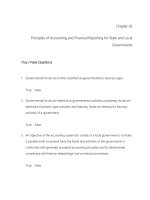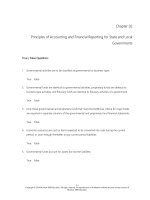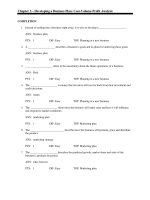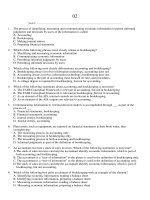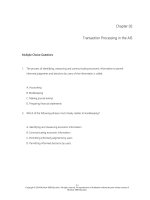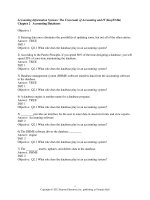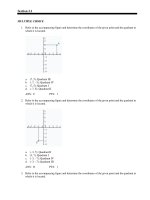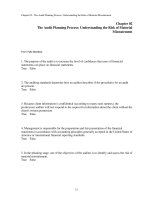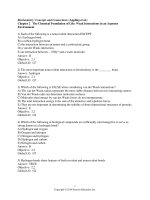Managerial accounting decision making and motivating performance 1st edition datar test bank
Bạn đang xem bản rút gọn của tài liệu. Xem và tải ngay bản đầy đủ của tài liệu tại đây (505.04 KB, 45 trang )
Managerial Accounting: Making Decisions and Motivating Performance (Datar/Rajan)
Chapter 2 An Introduction to Cost Terms and Purposes
Learning Objective 2-1
1) The cost incurred is:
A) actual costs.
B) budgeted costs.
C) cost object.
D) cost accumulation.
E) cost allocation.
Answer: A
Diff: 1 Page Ref: 31
LO: 2-1
EOC: E2-1; E2-6
AACSB: Reflective Thinking Skills
Learning Outcome: FA-2: Describe the components of and prepare the four basic financial statements.
2) A ________ is usually measured as the amount of money that must be paid to acquire goods and
services.
A) time
B) cost
C) goal
D) product
E) prediction
Answer: B
Diff: 1 Page Ref: 30
LO: 2-1
EOC: E2-10; E2-11
AACSB: Reflective Thinking Skills
Learning Outcome: FA-2: Describe the components of and prepare the four basic financial statements.
3) Which of the following explains why managers compare the budgeted costs to actual costs?
A) Managers only focus on the budgeted costs.
B) Managers only learn how to make better decisions in the future.
C) Managers know how well they did to control costs only.
D) Managers evaluate how well they did to control costs and learn how to do better in the future.
E) Managers never compare these costs.
Answer: D
Diff: 1 Page Ref: 30
LO: 2-1
EOC: E2-10; E2-11
AACSB: Reflective Thinking Skills
Learning Outcome: MA-2: Discuss the legal, ethical, and business concepts that affect managerial accounting.
1
Copyright © 2014 Pearson Education, Inc.
4) The cost object is:
A) the cost incurred.
B) a collection of cost data in some organized way by means of a cost object.
C) a predicted, or forecasted, cost.
D) anything for which a measurement of costs is desired.
E) used to describe the assignment of indirect costs to a particular cost object.
Answer: C
Diff: 1 Page Ref: 30
LO: 2-1
EOC: E2-1
AACSB: Reflective Thinking Skills
Learning Outcome: FA-2: Describe the components of and prepare the four basic financial statements.
5) Budgeted costs include:
A) the costs incurred this year.
B) the costs incurred last year.
C) the planned or forecasted costs.
D) the cost of a competitor.
E) the costs incurred two years ago.
Answer: C
Diff: 1 Page Ref: 30
LO: 2-1
EOC: E2-6
AACSB: Reflective Thinking Skills
Learning Outcome: FA-2: Describe the components of and prepare the four basic financial statements.
6) Cost accumulation:
A) is the cost incurred.
B) is a collection of cost data in an organized way by means of a cost object.
C) predicts, or forecasts, costs.
D) measures the desired costs.
E) describes the assignment of indirect costs to a particular cost object.
Answer: B
Diff: 1 Page Ref: 30
LO: 2-1
EOC: E2-1
AACSB: Reflective Thinking Skills
Learning Outcome: FA-2: Describe the components of and prepare the four basic financial statements.
2
Copyright © 2014 Pearson Education, Inc.
7) The two main ways managers use cost information are when they ________ decisions; and, ________
decisions.
A) make; implement
B) create; brainstorm
C) control; create
D) brainstorm; control
E) control; accumulate
Answer: A
Diff: 2 Page Ref: 30
LO: 2-1
EOC: E2-11
AACSB: Reflective Thinking Skills
Learning Outcome: MA-2: Discuss the legal, ethical, and business concepts that affect managerial accounting.
8) A/an ________ cost is the cost incurred; and they are distinguished from a ________ cost; which is a
predicted, forecasted, or future cost.
A) budget; object
B) actual; budgeted
C) accumulated; actual
D) budgeted; actual
E) cost object; actual
Answer: B
Diff: 3 Page Ref: 30
LO: 2-1
EOC: E2-10
AACSB: Analytic Skills
Learning Outcome: FA-2: Describe the components of and prepare the four basic financial statements.
9) The predicted, or forecasted costs, are:
A) actual costs.
B) budgeted costs.
C) cost object.
D) cost accumulation.
E) cost allocation.
Answer: B
Diff: 1 Page Ref: 31
LO: 2-1
EOC: E2-1
AACSB: Reflective Thinking Skills
Learning Outcome: FA-2: Describe the components of and prepare the four basic financial statements.
3
Copyright © 2014 Pearson Education, Inc.
10) Evans Manufacturing has three cost objects that it uses to accumulate costs for its manufacturing plant
in Virginia. They include:
Cost Object #1: The real estate dwelling(s) (physical buildings and equipment)
Cost Object #2: The use of buildings and equipment
Cost Object #3: The use and availability of manufacturing labor
The following manufacturing overhead cost categories are found in the accounting records:
a. Depreciation on buildings and equipment
b. Machine lubricants
c. Insurance for property
d. Supervisors salaries
e. Fringe benefits
f. Property taxes
g. Utilities
Required:
Assign each of the above costs to the most appropriate cost object.
Answer:
Cost Object #1 includes categories a, c and f
Cost Object #2 includes categories b and g
Cost Object #3 includes categories d and e
Diff: 2 Page Ref: 30
LO: 2-1
EOC: E2-14
AACSB: Analytic Skills
Learning Outcome: FA-2: Describe the components of and prepare the four basic financial statements.
11) A BMW X6 sports activity coupe is an example of the ________ cost object at BMW.
A) product
B) service
C) project
D) customer
E) activity
Answer: A
Diff: 1 Page Ref: 30
LO: 2-1
EOC: E2-1
AACSB: Reflective Thinking Skills
Learning Outcome: FA-2: Describe the components of and prepare the four basic financial statements.
4
Copyright © 2014 Pearson Education, Inc.
12) Accountants measure the cost of direct materials or advertising at manufacturing plants by using the
monetary amount paid to acquire them.
Answer: TRUE
Diff: 1 Page Ref: 30
LO: 2-1
EOC: E2-10
AACSB: Analytic Skills
Learning Outcome: MA-2: Discuss the legal, ethical, and business concepts that affect managerial accounting.
13) Budgeted costs are also known as predicted or forecasted costs (future costs).
Answer: TRUE
Diff: 1 Page Ref: 30
LO: 2-1
EOC: E2-11; E2-12; E2-13
AACSB: Reflective Thinking Skills
Learning Outcome: FA-2: Describe the components of and prepare the four basic financial statements.
14) Managers use their knowledge about costs to help guide their decisions about product innovation,
quality, and customer service.
Answer: TRUE
Diff: 1 Page Ref: 30
LO: 2-1
EOC: E2-18
AACSB: Reflective Thinking Skills
Learning Outcome: MA-2: Discuss the legal, ethical, and business concepts that affect managerial accounting.
15) The managers at BMW utilize their knowledge about costs to make decisions about product
innovation, quality, and customer service.
Answer: TRUE
Diff: 1 Page Ref: 30
LO: 2-1
EOC: E2-1
AACSB: Analytic Skills
Learning Outcome: MA-2: Discuss the legal, ethical, and business concepts that affect managerial accounting.
16) Recall that managers use a cost system to determine the costs of various cost objects. List and discuss
how managers use the two basic stages in this process to determine the cost.
Answer: The two stages that managers use are accumulation and assignment. In the first stage, managers
accumulate costs. For example, they collect, or accumulate, the cost data that they use in an accounting
system. In the second stage, assignment, managers assign the accumulated costs in various categories.
Diff: 2 Page Ref: 30
LO: 2-1
EOC: E2-1
AACSB: Reflective Thinking Skills
Learning Outcome: MA-2: Discuss the legal, ethical, and business concepts that affect managerial accounting.
5
Copyright © 2014 Pearson Education, Inc.
Learning Objective 2-2
1) The general term used to identify the tracing and allocation of accumulated costs to a cost object is:
A) cost accumulation.
B) cost assignment.
C) cost tracing.
D) conversion costing.
E) convertible costing.
Answer: B
Diff: 2 Page Ref: 31
LO: 2-2
EOC: E2-1
AACSB: Reflective Thinking Skills
Learning Outcome: FA-2: Describe the components of and prepare the four basic financial statements.
2) Cost tracing:
A) describes the assignment of direct costs to a particular cost object.
B) is the cost incurred which is a predicted or forecasted cost.
C) is the collection of data in some organized way.
D) is used to describe the assignment of indirect costs to a particular cost object.
E) encompasses both cost tracing and allocating indirect costs to a cost object.
Answer: A
Diff: 3 Page Ref: 31
LO: 2-2
EOC: E2-12; E2-13; E2-14
AACSB: Reflective Thinking Skills
Learning Outcome: FA-2: Describe the components of and prepare the four basic financial statements.
3) Which of the following is correct about indirect costs of a cost object?
A) Cost allocation is not used to describe the assignment of these costs to a particular cost object.
B) Cost tracing is used to describe its assignment of these costs to a particular cost object.
C) Can be traced to a cost object in an economically feasible way.
D) Cannot be traced to a cost object in an economically feasible way.
E) Cost assignment is not used in indirect costing methods.
Answer: C
Diff: 3 Page Ref: 31
LO: 2-2
EOC: E2-12; E2-13; E2-14
AACSB: Reflective Thinking Skills
Learning Outcome: FA-2: Describe the components of and prepare the four basic financial statements.
6
Copyright © 2014 Pearson Education, Inc.
4) The broader definition of a cost object is:
A) the higher proportion of costs that are direct costs and the managers are more confident in the
accuracy of the cost amounts.
B) the lower proportion of costs that are direct costs and the managers are more confident in the accuracy
of the cost amounts.
C) the higher proportion of costs that are indirect costs and the managers are less confident in the
accuracy of cost amounts.
D) the lower proportion of costs that are indirect costs and the managers are less confident in the
accuracy of cost amounts.
E) the managers are never confident in the accuracy of cost amounts.
Answer: A
Diff: 3 Page Ref: 32
LO: 2-2
EOC: E2-11
AACSB: Reflective Thinking Skills
Learning Outcome: FA-2: Describe the components of and prepare the four basic financial statements.
5) Which of the following is not a challenge to managers that allocate costs?
A) Assign inaccurate product costs.
B) Inaccurate product costs mislead managers about the profitability of products.
C) Managers will promote unprofitable products.
D) Managers deemphasize profitable products.
E) Assign accurate product costs.
Answer: E
Diff: 3 Page Ref: 31
LO: 2-2
EOC: E2-12; E2-13; E2-14
AACSB: Reflective Thinking Skills
Learning Outcome: MA-2: Discuss the legal, ethical, and business concepts that affect managerial accounting.
6) Which of the following statements about the direct or indirect cost classification is not true?
A) Indirect costs are always traced.
B) Indirect costs are always allocated.
C) The design of operations affects the direct or indirect cost classification.
D) The direct/indirect classification depends on the choice of the cost object.
E) All of these statements are true.
Answer: A
Diff: 2 Page Ref: 31
LO: 2-2
EOC: E2-11
AACSB: Analytic Skills
Learning Outcome: FA-2: Describe the components of and prepare the four basic financial statements.
7
Copyright © 2014 Pearson Education, Inc.
7) We define cost tracing as:
A) the assignment of direct costs to a chosen cost object.
B) a function of cost allocation.
C) the process of tracking both direct and indirect costs associated with a cost object.
D) the process of determining the actual cost of the cost object.
E) the process of tracking only the direct and indirect costs.
Answer: A
Diff: 1 Page Ref: 31
LO: 2-2
EOC: E2-11
AACSB: Reflective Thinking Skills
Learning Outcome: FA-2: Describe the components of and prepare the four basic financial statements.
8) We define cost allocation as:
A) the process of tracking both direct and indirect costs associated with a cost object.
B) the process of determining the actual cost of the cost object.
C) the assignment of indirect costs to the chosen cost object.
D) a function of cost tracing.
E) not a function of cost assignment.
Answer: C
Diff: 2 Page Ref: 31
LO: 2-2
EOC: E2-11
AACSB: Reflective Thinking Skills
Learning Outcome: FA-2: Describe the components of and prepare the four basic financial statements.
9) Indirect costs of a cost object can be traced to a specific cost object and direct costs of a cost object
cannot be traced to a specific cost object.
Answer: FALSE
Explanation: Indirect costs of a cost object are related to the particular cost object but cannot be traced to
it in an economically feasible way. Direct costs of a cost object are related to the particular cost object and
can be traced to it in an economically feasible way.
Diff: 1 Page Ref: 31
LO: 2-2
EOC: E2-11
AACSB: Reflective Thinking Skills
Learning Outcome: FA-2: Describe the components of and prepare the four basic financial statements.
10) Cost tracing is used to describe the assignment of indirect costs to a particular cost object.
Answer: FALSE
Explanation: The term cost tracing is used to describe the assignment of direct costs to a particular cost
object.
Diff: 2 Page Ref: 31
LO: 2-2
EOC: E2-18; E2-19
AACSB: Reflective Thinking Skills
Learning Outcome: FA-2: Describe the components of and prepare the four basic financial statements.
8
Copyright © 2014 Pearson Education, Inc.
11) One highlight of indirect costs of a cost object is that it can be traced in an economically feasible way.
Answer: FALSE
Explanation: Indirect costs of a cost object are related to the particular cost object but cannot be traced to
it in an economically feasible way.
Diff: 2 Page Ref: 31
LO: 2-2
EOC: E2-18; E2-19
AACSB: Reflective Thinking Skills
Learning Outcome: MA-2: Describe the components of and prepare the four basic financial statements.
12) The cost of steel and tires to an automobile manufacturer is an example of a direct cost.
Answer: TRUE
Diff: 1 Page Ref: 31
LO: 2-2
EOC: E2-19
AACSB: Reflective Thinking Skills
Learning Outcome: FA-2: Describe the components of and prepare the four basic financial statements.
13) Ford Motor Company is an example of a plant that manufactures automobiles. The cost of the lease
where it manufactures automobiles can be categorized as an indirect cost.
Answer: TRUE
Diff: 2 Page Ref: 31
LO: 2-2
EOC: E2-11
AACSB: Analytic Skills
Learning Outcome: FA-2: Describe the components of and prepare the four basic financial statements.
14) In general, a manager is more confident about the accuracy of direct costs of cost objects.
Answer: TRUE
Diff: 2 Page Ref: 31
LO: 2-2
EOC: E2-11
AACSB: Reflective Thinking Skills
Learning Outcome: MA-2: Discuss the legal, ethical, and business concepts that affect managerial accounting.
15) The plant administrative costs at a manufacturing company are indirect costs.
Answer: TRUE
Diff: 1 Page Ref: 31
LO: 2-2
EOC: E2-11
AACSB: Reflective Thinking Skills
Learning Outcome: FA-2: Describe the components of and prepare the four basic financial statements.
9
Copyright © 2014 Pearson Education, Inc.
16) Write a short essay and explain why a manager at a manufacturing company considers the direct
costs to be more accurate than indirect costs.
Answer: Managers at manufacturing companies consider the direct costs to be more accurate than
indirect costs because they can be traced to a specific or particular cost object. Indirect costs, for example,
the salaries of administrative personnel at a manufacturing company, can't be traced to a specific cost
object.
Diff: 3 Page Ref: 31
LO: 2-2
EOC: E2-11; E2-14
AACSB: Analytic Skills
Learning Outcome: MA-2: Discuss the legal, ethical, and business concepts that affect managerial accounting.
17) Write a short essay and explain how technological advances have improved the accounting or finance
manager's ability to track costs. Be specific.
Answer: Managers enjoy the advances in information-gathering technology because it enhances their
ability to trace direct costs. The development of bar codes now permit managers to classify low-cost
products, for example, clips and screws that were previously classified as indirect costs.
Diff: 2 Page Ref: 32
LO: 2-2
EOC: E2-11
AACSB: Use of Information Technology
Learning Outcome: MA-2: Discuss the legal, ethical, and business concepts that affect managerial accounting.
18) Write a short essay and explain why it is important for managers to assign costs accurately to cost
objects. What are some of the challenges that managers face when they allocate costs to cost objects?
Answer: It is important for managers to assign costs accurately to cost objects because the data reported
and assigned to the product will not be accurate. Inaccurate product costs results in the inaccurate
profitability of different products. As a result, the manager may select to promote the unprofitable
product instead of the profitable product. If costs are consistently inaccurate it could affect the long-term
profit forecast of the product.
One challenge to a manager is the allocation of indirect administrative costs. Managers must decide
whether the administrative costs are calculated by the number or products produced or by the number of
administrative workers that produce the product.
Diff: 3 Page Ref: 31-32
LO: 2-2
EOC: E2-10
AACSB: Analytic Skills
Learning Outcome: MA-2: Describe the components of and prepare the four basic financial statements.
10
Copyright © 2014 Pearson Education, Inc.
19) Write a short essay and discuss some of the factors that affect the classification of direct and indirect
costs.
Answer: Some of the factors that affect the classification of direct and indirect costs include the
materiality of the cost in question, the available technology used to gather information, and the design of
the operations. In addition, managers must learn to make logical decisions based on the cost object
depending on the purpose of the cost because in certain cases, a cost could be classified as a direct cost or
an indirect cost.
Diff: 2 Page Ref: 32
LO: 2-2
EOC: E2-11
AACSB: Analytic Skills
Learning Outcome: MA-2: Discuss the legal, ethical, and business concepts that affect managerial accounting.
20) Write a brief summary and discuss why cost allocation is important to a manager. Discuss some of the
challenges that managers face when they allocate costs and discuss those factors that affect the
direct/indirect cost classification. Be specific.
Answer: Cost allocation is important to a manager because they must assign costs accurately to a cost
object. Managers are challenged to ensure costs are appropriately allocated to a product. For example, if
the product costs are not accurate, the true profitability to products is distorted. As a result, a manager
could sell a product that should not be sold because it is not profitable to the company.
Some of the factors that affect cost classification include the materiality of the cost in question, the amount
of available information-gathering technology, and the product design.
Diff: 3 Page Ref: 31
LO: 2-2
EOC: E2-10; E2-11
AACSB: Analytic Skills
Learning Outcome: MA-2: Discuss the legal, ethical, and business concepts that affect managerial accounting.
11
Copyright © 2014 Pearson Education, Inc.
Learning Objective 2-3
1) The costing systems that managers use to identify the cost of each activity such as testing, design, or
set-up are called:
A) product-based costing systems.
B) action-based costing systems.
C) managerial-based costing systems.
D) activity-based costing systems.
E) resource-based costing systems.
Answer: D
Diff: 3 Page Ref: 35
LO: 2-3
EOC: E2-12; E2-13; E2-14
AACSB: Reflective Thinking Skills
Learning Outcome: FA-2: Describe the components of and prepare the four basic financial statements.
2) Financial accountants realize that a mixed cost is:
A) a fixed cost.
B) a cost with fixed and variable elements.
C) a variable cost.
D) always an indirect cost.
E) only an indirect cost.
Answer: B
Diff: 1 Page Ref: 35
LO: 2-3
EOC: E2-11
AACSB: Reflective Thinking Skills
Learning Outcome: FA-2: Describe the components of and prepare the four basic financial statements.
3) An example of a mixed cost is:
A) monthly rent payments.
B) manager's salary.
C) monthly electric bill.
D) direct materials.
E) none of these are mixed costs.
Answer: C
Diff: 2 Page Ref: 35
LO: 2-3
EOC: E2-3
AACSB: Analytic Skills
Learning Outcome: FA-2: Describe the components of and prepare the four basic financial statements.
12
Copyright © 2014 Pearson Education, Inc.
4) Fixed and variable costs:
A) always change in the same proportion.
B) are defined as variable or fixed for a specific activity for a given time period.
C) are only defined for a specific activity and never for a given period of time.
D) are only defined for a given period of time and not for a specific activity.
E) are never useful to managers when they make cost decisions.
Answer: B
Diff: 3 Page Ref: 35
LO: 2-3
EOC: E2-15; E2-16; E2-17
AACSB: Reflective Thinking Skills
Learning Outcome: FA-2: Describe the components of and prepare the four basic financial statements.
5) Which of the following is not a true statement about variable costs?
A) A total cost that can change in proportion to changes in the number of product produced.
B) An important cost to identify so managers can make important management decisions.
C) Total cost never changes in proportion to any changes in related levels of volume or activity.
D) When considering total cost behavior, focus on total costs.
E) Total cost is known to change in proportion to any changes in related level of volume or activity.
Answer: C
Diff: 3 Page Ref: 32
LO: 2-3
EOC: E2-15; E2-16; E2-17
AACSB: Reflective Thinking Skills
Learning Outcome: FA-2: Describe the components of and prepare the four basic financial statements.
6) A band of normal activity or volume in which specific cost-volume relationships are maintained is
referred to as the:
A) average range.
B) cost-allocation range.
C) cost drive range.
D) relevant range.
E) driving range.
Answer: D
Diff: 1 Page Ref: 35
LO: 2-3
EOC: E2-17
AACSB: Reflective Thinking Skills
Learning Outcome: FA-2: Describe the components of and prepare the four basic financial statements.
13
Copyright © 2014 Pearson Education, Inc.
7) If each motorcycle requires a fan belt that costs $20 and 2,000 motorcycles are produced in the month,
the total cost for the fan belts is:
A) considered to be a fixed cost.
B) considered to be a direct variable cost.
C) considered to be an indirect fixed cost.
D) considered to be an indirect variable cost.
E) none of these are true.
Answer: B
Diff: 3 Page Ref: 33
LO: 2-3
EOC: E2-20
AACSB: Analytic Skills
Learning Outcome: FA-2: Describe the components of and prepare the four basic financial statements.
8) Answer the question using the information provided below:
Number of Custom
Carburetors Produced
Variable Cost Per Custom
Carburetors
Total Fixed Cost Per
Custom Carburetor
(1)
1
500
1000
(2)
$50
50
50
(3)
$50
The manager at the Carburetor Factory buys a custom carburetor at $50.00 each for each of its custom
vehicles. Compute the total fixed cost per custom carburetor if 1, 500, and 1,000 custom carburetors are
produced.
A) $25,000; $50,000
B) $30,000; $60,000
C) $35,000; $70,000
D) $40,000; $45,000
E) $45,000; $90,000
Answer: A
Explanation: A) Total cost changes in proportion to the changes of the number of units produced
Number of Custom
Carburetors Produced
Variable Cost Per
Custom Carburetors
Total Fixed Cost Per
Custom Carburetor
(1)
1
500
1000
(2)
$50
50
50
(3) = 1 × 2
$50
$25,000
$50,000
Diff: 2 Page Ref: 33
LO: 2-3
EOC: E2-3
AACSB: Analytic Skills
Learning Outcome: FA-2: Describe the components of and prepare the four basic financial statements.
14
Copyright © 2014 Pearson Education, Inc.
9) Answer the question below using the following information:
Annual Total Fixed
Supervision Costs for
Carburetor Assembly Line
(1)
$2,500,000
$2,500,000
$2,500,000
Number of Carburetors
Produced
Fixed Supervision Cost Per
Custom Carburetor
(2)
5,000
10,000
15,000
(3)
Required:
Compute the fixed supervision cost per custom carburetor for 5,000, 10,000, and 15,000 carburetors
produced.
A) $250; $300
B) $250; $166.66
C) $150; $100
D) $200; $300
E) $50; $25
Answer: B
Explanation: B) Fixed costs become smaller and smaller on a per-unit basis as the number of vehicles
assembled increase.
Annual Total Fixed Number of Carburetors Fixed Supervision Cost
Supervision Costs for
Produced
Per Custom Carburetor
Carburetor Assembly
Line
(1)
(2)
(3) = (1) ÷ (2)
$2,500,000
5,000
$500
$2,500,000
10,000
$250
$2,500,000
15,000
$166.66
Diff: 3 Page Ref: 33
LO: 2-3
EOC: E2-3
AACSB: Analytic Skills
Learning Outcome: FA-2: Describe the components of and prepare the four basic financial statements.
15
Copyright © 2014 Pearson Education, Inc.
10) The managerial accountant at Sahara Organizations matches business functions to cost drivers. The
list below provides representative cost drivers in the right column are randomized with respect to the list
of functions in the left column [Note: These are not matched to the respective cost driver].
1
2
3
4
5
6
Business Function
Billing
Purchasing
Shipping
Computer Support
Personnel
Customer Service
A
B
C
D
E
F
Representative Cost Driver
Number of shipments
Number of employees
Number of customers
Number of invoices
Number of desktop computers
Number of purchase orders
Numbers 1-6 represent the Business Functions and the letters A-F represent the cost drivers at the
company.
Required:
Insert the letter of the appropriate cost driver (A through F) and match each business function with its
appropriate cost driver.
1
2
3
4
5
6
FUNCTION
Billing
Purchasing
Shipping
Computer Support
Personnel
Customer Services
Insert letter of appropriate cost
driver (Letters A-F)
Answer: D, F, A, E, B, C
Explanation:
1
2
3
4
5
6
FUNCTION
Billing
Purchasing
Shipping
Computer Support
Personnel
Customer Services
Insert letter of appropriate cost
driver (Letters A-F)
D
F
A
E
B
C
Diff: 2 Page Ref: 35
LO: 2-3
EOC: E2-4
AACSB: Analytic Skills
Learning Outcome: FA-2: Describe the components of and prepare the four basic financial statements.
16
Copyright © 2014 Pearson Education, Inc.
11) A manager at an airline must purchase individual annual licenses and pay registration costs for each
airplane in the fleet of airplanes they operate at the airport. What type of cost is/are the registration and
license costs for the miles flown each year for each individual airplane?
A) Fixed and variable cost for the miles flown by each individual plane.
B) Mixed cost for the miles flown by all planes each year.
C) Fixed cost for the miles flown by each individual plane.
D) Variable cost for the miles flown by each individual plane.
E) Licenses and registrations are not considered costs to the airline.
Answer: C
Diff: 3 Page Ref: 39
LO: 2-3
EOC: E2-16; E2-21
AACSB: Analytic Skills
Learning Outcome: MA-2: Describe the components of and prepare the four basic financial statements.
12) Costs are defined as variable or fixed for a specific activity and for a given time period.
Answer: TRUE
Diff: 1 Page Ref: 32
LO: 2-3
EOC: E2-11; E2-12; E2-13; E2-14; E2-15; E2-16
AACSB: Reflective Thinking Skills
Learning Outcome: FA-2: Describe the components of and prepare the four basic financial statements.
13) Fixed costs can be changed quickly to match the amount of resources that are needed or used in the
organization.
Answer: FALSE
Explanation: Unlike variable costs, fixed costs of resources cannot be quickly and easily changed to
match the resources needed or used.
Diff: 2 Page Ref: 34
LO: 2-3
EOC: E2-11
AACSB: Reflective Thinking Skills
Learning Outcome: FA-2: Describe the components of and prepare the four basic financial statements.
14) Costs that have both fixed and variable elements are called mixed costs or semivariable costs.
Answer: TRUE
Diff: 1 Page Ref: 35
LO: 2-3
EOC: E2-15; E2-16; E2-17
AACSB: Reflective Thinking Skills
Learning Outcome: FA-2: Describe the components of and prepare the four basic financial statements.
17
Copyright © 2014 Pearson Education, Inc.
15) Outside the relevant range, variable costs, such as direct materials, may not change proportionately
with changes in production volume.
Answer: TRUE
Diff: 2 Page Ref: 36
LO: 2-3
EOC: E2-5; E2-16; E2-17
AACSB: Reflective Thinking Skills
Learning Outcome: FA-2: Describe the components of and prepare the four basic financial statements.
16) Write a short essay and explain how managers differentiate between fixed costs and variable costs.
Answer: Managers understand that total fixed costs do not change in the time-period observed despite
the changes in the level of activity or volume. However, the variable costs do change in proportion to
changes in the total level of activity or volume.
Diff: 2 Page Ref: 32
LO: 2-3
EOC: E2-11; E2-15; E2-16; E2-17
AACSB: Analytic Skills
Learning Outcome: MA-2: Discuss the legal, ethical, and business concepts that affect managerial accounting.
17) Write a short essay and discuss whether or not managers should assume that individual cost items are
inherently fixed or variable? Why are some costs fixed and other costs variable costs?
Answer: No, managers should never assume that individual cost items are inherently fixed or variable.
For example, a labor cost can be a variable cost for the units produced when those workers are paid on a
piece-rate, or piece-unit, basis. Forecasted labor costs at a plant could be considered a fixed cost in the
next fiscal accounting period.
Diff: 2 Page Ref: 34
LO: 2-3
EOC: E2-20
AACSB: Analytic Skills
Learning Outcome: MA-2: Discuss the legal, ethical, and business concepts that affect managerial accounting.
18) Write a brief summary and explain how the impact of a financial crisis impacts how managers at
global companies account for fixed costs. Be specific.
Answer: Managers that work at global companies are reluctant to lock in fixed costs. Certain policies
could increase the risk of losses during economic downturns. In addition, if there is a decrease in
revenues that result from an economic crisis, the fixed costs remain unchanged. If there is a decrease in
the revenues, it will prevent problems in the organization.
Diff: 3 Page Ref: 34
LO: 2-3
EOC: E2-11
AACSB: Dynamics of the Global Economy
Learning Outcome: MA-2: Discuss the legal, ethical, and business concepts that affect managerial accounting.
18
Copyright © 2014 Pearson Education, Inc.
19) Write an essay and define relevant range. Discuss what the relevant range is and explain why it is
important to managers?
Answer: The relevant range is known as the band or range of normal activity level or volume in which
there is a specific relationship between the level of activity or volume and the cost in question. Managers
are concerned about the relevant range because it is known as the region of activity where a particular
relationship holds between a driver and a cost. Managers also observe variable costs because they many
not change in proportion to changes in volume.
Diff: 2 Page Ref: 35
LO: 2-3
EOC: E2-17; E2-18
AACSB: Reflective Thinking Skills
Learning Outcome: FA-2: Describe the components of and prepare the four basic financial statements.
Learning Objective 2-4
1) Which of the following is not true about unit costs?
A) Decision makers think in terms of total costs rather than unit costs.
B) Decision makers think in terms of unit costs rather than total costs.
C) Calculating unit cost is essential.
D) Unit costs are also known as average costs.
E) Managers can express costs in various ways.
Answer: B
Diff: 2 Page Ref: 37
LO: 2-4
EOC: E2-20; E2-21
AACSB: Reflective Thinking Skills
Learning Outcome: FA-2: Describe the components of and prepare the four basic financial statements.
2) Managers compute the unit cost by:
A) multiplying total cost by the number of units.
B) dividing total cost by the number of units.
C) dividing variable cost by the number of units.
D) adding variable cost to fixed cost.
E) adding variable, direct, and indirect costs.
Answer: B
Diff: 2 Page Ref: 37
LO: 2-4
EOC: E2-20; E2-21
AACSB: Reflective Thinking Skills
Learning Outcome: FA-2: Describe the components of and prepare the four basic financial statements.
19
Copyright © 2014 Pearson Education, Inc.
3) Unit costs are found in:
A) only the production department.
B) only the sales department.
C) all areas of the value chain.
D) only in the marketing department.
E) only in the human resource department.
Answer: C
Diff: 2 Page Ref: 37
LO: 2-4
EOC: E2-6
AACSB: Reflective Thinking Skills
Learning Outcome: FA-2: Describe the components of and prepare the four basic financial statements.
4) When 40,000 units are produced, fixed costs are $16 per unit. Therefore, when 80,000 units are
produced, fixed costs will:
A) increase to $32 per unit.
B) remain at $16 per unit.
C) decrease to $8 per unit.
D) total $640,000.
E) total $540,000.
Answer: C
Diff: 3 Page Ref: 37-38
LO: 2-4
EOC: E2-20; E2-21
AACSB: Analytic Skills
Learning Outcome: FA-2: Describe the components of and prepare the four basic financial statements.
5) When 5,000 units are produced, variable costs are $6 per unit. Therefore, when 20,000 units are
produced:
A) variable costs will total $120,000.
B) variable costs will total $60,000.
C) variable unit costs will increase to $12 per unit.
D) variable unit costs will decrease to $3 per unit.
E) variable costs will decrease to $2 per unit.
Answer: A
Diff: 3 Page Ref: 38
LO: 2-4
EOC: E2-20; E2-21
AACSB: Analytic Skills
Learning Outcome: FA-2: Describe the components of and prepare the four basic financial statements.
20
Copyright © 2014 Pearson Education, Inc.
6) Accounting systems report:
A) only the total cost amounts.
B) only the average-cost per unit amounts.
C) both total-cost amounts and average-cost per unit amounts.
D) only average costs.
E) no cost amount data.
Answer: C
Diff: 2 Page Ref: 37
LO: 2-4
EOC: E2-18
AACSB: Use of Information Technology
Learning Outcome: MA-2: Describe the components of and prepare the four basic financial statements.
7) As a general rule, managers first calculate total costs, and then compute which of the following costs
when they need to make decisions?
A) A direct cost.
B) A unit cost.
C) A variable cost.
D) An indirect cost.
E) A cost driver.
Answer: B
Diff: 3 Page Ref: 38
LO: 2-4
EOC: E2-20; E2-21
AACSB: Analytic Skills
Learning Outcome: FA-2: Describe the components of and prepare the four basic financial statements.
8) Acme Candle Company reported the following information:
Manufacturing costs
Units Manufactured
Units sold (60,000 units sold at $25 per unit)
Beginning inventory
$1,500,000
300,000
$1,500,000
0 units
Required:
Compute the average manufacturing cost per unit.
A) $1.00
B) $1.75
C) $2.95
D) $4.50
E) $5.00
Answer: E
Explanation: E) ($1,500,000 / 300,000) = $5 per unit
Diff: 2 Page Ref: 37-38
LO: 2-4
EOC: E2-33
AACSB: Analytic Skills
Learning Outcome: FA-2: Describe the components of and prepare the four basic financial statements.
21
Copyright © 2014 Pearson Education, Inc.
9) Jim's Manufacturing currently produces 1,250 brakes per month. The following per unit data apply for
sales to regular customers:
Direct materials
Direct manufacturing labor
Variable manufacturing overhead
Fixed manufacturing overhead
Total manufacturing costs
$225
28
50
35
$338
The plant has capacity for 2,000 brakes.
Required:
a. What is the total cost of producing 1,000 brakes?
b. What is the total cost of producing 1,500 brakes?
c. What is the per-unit cost when producing 1,500 brakes?
Answer:
a. [($225 + $28 + $50) × 1,000 units] + ($35 × 1,250 units) = $346,750
b. [($225 + $28 + $50) × 1,500 units] + $43,750) = $498,250
c. ($498,250 ÷ 1,500) = $332.16 per unit
Diff: 2 Page Ref: 38
LO: 2-4
EOC: E2-20; E2-21
AACSB: Analytic Skills
Learning Outcome: FA-2: Describe the components of and prepare the four basic financial statements.
10) During 2011, Maryland Corporation incurred manufacturing expenses of $15,000,000 to produce
300,000 finished units. At year-end, it was determined that 250,000 units were sold while 25,000 units
remained in ending inventory.
Required:
a.
Compute the cost to produce one unit.
b.
Compute the amount that will be reported on the income statement for cost of goods sold.
c.
Compute the amount that will be reported on the balance sheet for ending inventory.
Answer:
a. $15,000,000 ÷ 300,000 = $50.00
b. 250,000 units × $50 = $12,500,000
c. 25,000 units × $50 = $1,250,000
Diff: 2 Page Ref: 37-38
LO: 2-4
EOC: E2-20; E2-21
AACSB: Analytic Skills
Learning Outcome: FA-2: Describe the components of and prepare the four basic financial statements.
22
Copyright © 2014 Pearson Education, Inc.
11) Managers should think in terms of unit costs rather than terms of total costs for many decisions.
Answer: FALSE
Explanation: Managers should think in terms of total costs rather than terms of total costs for many
decisions.
Diff: 2 Page Ref: 38
LO: 2-4
EOC: E2-20; E2-21
AACSB: Reflective Thinking Skills
Learning Outcome: FA-2: Describe the components of and prepare the four basic financial statements.
12) The unit cost, or average cost, is the ratio of total costs to the number of units produced.
Answer: TRUE
Diff: 1 Page Ref: 38
LO: 2-4
EOC: E2-20
AACSB: Reflective Thinking Skills
Learning Outcome: FA-2: Describe the components of and prepare the four basic financial statements.
13) Write a short essay and discuss how unit costs are calculated. Discuss how unit costs are related to the
value chain.
Answer: Unit costs are also known as the average cost. Unit costs can be calculated by dividing total cost
by the related number of units. Unit costs are directly related to the value chain because they can be
summed in all areas of the value chain. Managers can sum unit costs of different products and services
and determine whether or not the product or service is profitable. This information is useful to managers
because they use the information to determine which products that they will invest more resources in and
the prices that they can charge for the products and services.
Diff: 3 Page Ref: 37
LO: 2-4
EOC: E2-18; E2-20; E2-21
AACSB: Analytic Skills
Learning Outcome: FA-2: Describe the components of and prepare the four basic financial statements.
23
Copyright © 2014 Pearson Education, Inc.
Learning Objective 2-5
1) Which of the following is not a characteristic of the type of inventory used in manufacturing-type
sector companies?
A) Direct materials inventory.
B) Work-in process inventory.
C) Finished goods inventory.
D) Materials in stock and waiting to use.
E) Products already manufactured and sold.
Answer: E
Diff: 2 Page Ref: 38
LO: 2-5
EOC: E2-13
AACSB: Reflective Thinking Skills
Learning Outcome: FA-2: Describe the components of and prepare the four basic financial statements.
2) Which of the following is not a commonly used classification or characteristic of manufacturing costs?
A) Direct material costs.
B) Direct manufacturing labor costs.
C) Indirect manufacturing costs.
D) Freight-in charges.
E) Cost of goods sold.
Answer: E
Diff: 2 Page Ref: 39
LO: 2-5
EOC: E2-13
AACSB: Reflective Thinking Skills
Learning Outcome: FA-2: Describe the components of and prepare the four basic financial statements.
3) All costs of a product that are considered as assets in the balance sheet when they are incurred and that
become cost of goods sold only when the product is sold are:
Answer: inventoriable costs.
Diff: 2 Page Ref: 39
LO: 2-5
EOC: E2-22
AACSB: Reflective Thinking Skills
Learning Outcome: FA-2: Describe the components of and prepare the four basic financial statements.
4) Which of the following is normally included in direct materials inventory?
A) Direct materials in stock and awaiting use in the manufacturing process.
B) Goods partially worked on but not yet fully completed.
C) Goods fully completed but not yet sold.
D) Products in their original form intended to be sold without changing their basic form.
E) Goods and products that have been completed and sold.
Answer: A
Diff: 1 Page Ref: 39
LO: 2-5
EOC: E2-14
AACSB: Reflective Thinking Skills
Learning Outcome: FA-2: Describe the components of and prepare the four basic financial statements.
24
Copyright © 2014 Pearson Education, Inc.
5) In finished goods inventory:
A) direct materials are in stock and awaiting use in the manufacturing process.
B) goods are partially worked on but not yet fully completed.
C) goods are fully completed but not yet sold.
D) products are in their original form intended to be sold but the basic form is changed basic form.
E) goods are partially completed and sold as is.
Answer: C
Diff: 1 Page Ref: 39
LO: 2-5
EOC: E2-13
AACSB: Reflective Thinking Skills
Learning Outcome: FA-2: Describe the components of and prepare the four basic financial statements.
6) Manufacturing-sector companies purchase materials and components and convert them into various
finished goods.
Answer: TRUE
Diff: 1 Page Ref: 38
LO: 2-5
EOC: E2-14
AACSB: Reflective Thinking Skills
Learning Outcome: FA-2: Describe the components of and prepare the four basic financial statements.
7) Merchandising-sector companies purchase and then sell tangible products without changing their
basic form.
Answer: TRUE
Diff: 1 Page Ref: 38
LO: 2-5
EOC: E2-13
AACSB: Reflective Thinking Skills
Learning Outcome: FA-2: Describe the components of and prepare the four basic financial statements.
8) Service-sector companies are known as companies that provide products to its customers.
Answer: FALSE
Explanation: Service-sector companies provide services to its customers.
Diff: 1 Page Ref: 39
LO: 2-5
EOC: E2-12
AACSB: Reflective Thinking Skills
Learning Outcome: FA-2: Describe the components of and prepare the four basic financial statements.
9) Service-sector companies only provide services or intangible products and so do not hold inventories
of tangible products.
Answer: TRUE
Diff: 2 Page Ref: 39
LO: 2-5
EOC: E2-12
AACSB: Reflective Thinking Skills
Learning Outcome: FA-2: Describe the components of and prepare the four basic financial statements.
25
Copyright © 2014 Pearson Education, Inc.
